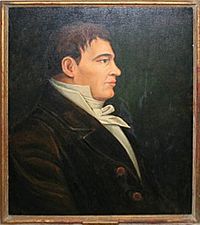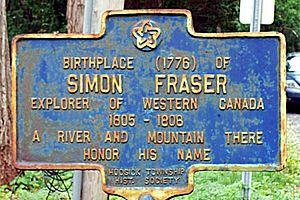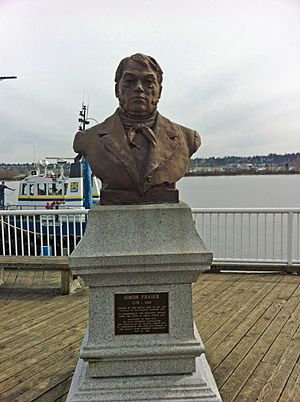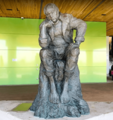Simon Fraser (explorer) facts for kids
Quick facts for kids
Simon Fraser
|
|
|---|---|

Pre-1825 portrait of Fraser
|
|
| Born | 20 May 1776 |
| Died | August 18, 1862 (aged 86) St. Andrews West, Canada
|
| Occupation | Wintering Partner in the North West Company |
| Spouse(s) | Catherine McDonell |
| Children | Nine altogether, one died at infancy |
| Parent(s) | Isabella Grant and Simon Fraser II |
Simon Fraser (born May 20, 1776 – died August 18, 1862) was a famous fur trader and explorer. He was from Scottish family roots. He mapped a lot of what is now the Canadian province of British Columbia. He also built the first European settlement there.
Fraser worked for the Montreal-based North West Company. By 1805, he was in charge of all the company's work west of the Rocky Mountains. He built the first trading posts in that area. In 1808, he explored the river now called the Fraser River, which is named after him. His explorations helped set Canada's border at the 49th parallel. This happened after the War of 1812. He was a British subject and the first European to set up lasting settlements in the area.
Contents
Simon Fraser's Early Life

Simon Fraser was born on May 20, 1776. He was born in Mapletown, Hoosick, New York. He was the youngest of eight children. His father was Captain Simon Fraser. His mother was Isabella Grant.
Simon's father came to North America in 1773. He died in prison after being captured during the Battle of Bennington in 1777. After the war, Simon's mother got help from her brother-in-law. He was Captain John Fraser, a judge in Montreal.
Working in the Fur Trade
When he was 14, Fraser moved to Montreal for more schooling. Two of his uncles were active in the fur trade. A relative, Simon McTavish, was a very important person in the fur trade. In 1790, Simon Fraser started working for the North West Company as an apprentice.
Exploring West of the Rocky Mountains
In 1789, the North West Company asked Alexander Mackenzie to find a river route to the Pacific Ocean. He found a route in 1793. It opened up new places to find fur. But it was too hard to use for trading.
Fraser was given the job of expanding operations west of the Rockies in 1805. Mackenzie's trips were mostly to look around. Fraser's job was different. He had to build trading posts and claim the land. He also had to find good travel routes.
Setting up Posts and Ascending the Peace River
In the fall of 1805, Fraser started going up the Peace River. He built a trading post called Rocky Mountain Portage House. This is now Hudson's Hope. It was just east of the Peace River Canyon. That winter, Fraser and his team went through the mountains. They went up the Parsnip and Pack Rivers. They built Trout Lake Fort. This fort was later called Fort McLeod. It is now at McLeod Lake. This was the first lasting European settlement west of the Rockies in Canada. Fraser named this area New Caledonia. He did this to honor his family's home in Scotland.
Another explorer, James McDougall, found Carrier Lake. This lake is now called Stuart Lake. This area was good for fur trading. So, a post called Fort St. James was built there in 1806. From here, Fraser sent another helper, John Stuart, west to Fraser Lake. Later, they built another post there. It is now called Fort Fraser.
Delays and Founding Fort George
Fraser learned from Indigenous people that the Fraser River could be reached. He found out he could go down the Stuart River from Stuart Lake. Then he could go down the Nechako River to where it met the Fraser River. Fraser planned to travel the whole length of the river that now has his name. Fraser and others thought this river was the Columbia River. The mouth of the Columbia River had been explored in 1792.
Fraser's plan to start his journey in 1806 had to be stopped. There were not enough men or supplies. There was also a local famine. Fraser did not get new supplies until the fall of 1807. This meant his journey could not start until the next spring. During this time, Fraser traveled to where the Nechako and Fraser Rivers met. There, he built a new post called Fort George. This is now Prince George. This fort would be the starting point for his trip downstream.
Traveling Down the Fraser River
From the start, the local people warned Fraser. They said the river below was almost impossible to travel. A group of twenty-four men left Fort George on May 28, 1808. They used four canoes. They passed the West Road River where Mackenzie had turned west. On June 1, they went through the rapids of the Cottonwood Canyon. A canoe got stuck there and had to be pulled out with a rope.
They got horses from the Indigenous people to help carry things. But the paths were still dangerous. They passed the mouth of the Chilcotin River on June 5. Then they entered a place where the river was completely surrounded by cliffs. The next day, the river was impossible to pass. They hid their canoes and extra goods. On June 11, the group started walking. Each man carried about 80 pounds. On June 14, they reached a large village. It was possibly near Lillooet. There, they traded for two canoes. On June 19, they reached a village at the mouth of the Thompson River. They got canoes for the rest of the group there.
After more rapids and carrying places, they lost one canoe but no men. They reached North Bend. There, they had to leave their canoes again. In some places, they used a path made by poles on the side of the gorge. This was probably near Hells Gate. On June 28, they left the Fraser Canyon near Yale. Here, the river became easier to travel. Friendly Indigenous people helped them. They ate salmon and reached the sea on July 2. Fraser measured the latitude as 49°. He knew the Columbia River's mouth was at 46°. So, it was clear this was not the Columbia River.
Fraser was good at making friends with the tribes he met. He made sure they sent messages to tribes downstream. These messages told them he was coming and had good intentions. This plan usually worked. But Fraser met a hostile group, the Musqueam people. This was as he got close to the lower part of the river near Vancouver. Their hostile chase meant Fraser could only see a little bit of the Strait of Georgia on July 2, 1808. A disagreement with the nearby Kwantlen people led to another chase. This chase only stopped near Hope.
Going back to Fort George was even more dangerous. The hostility Fraser and his team faced near the river's mouth spread upstream. The ongoing hostility and threats made Fraser's crew almost mutiny. They wanted to escape by land. Fraser stopped the revolt. He and his men continued north upstream from Yale. They arrived at Fort George on August 6, 1808. The journey upstream took thirty-seven days. In total, it took Fraser and his crew two and a half months to travel from Fort George to Musqueam and back.
Simon Fraser and the Battle of Seven Oaks
Fraser was only thirty-two years old when he finished setting up lasting European settlements in New Caledonia. He did this through his amazing journey to the mouth of the river that would later be named after him. He continued to work in the North West Company's fur trade for another eleven years. He was moved to the Athabasca Department and stayed there until 1814. For much of this time, he was in charge of the Mackenzie River District.
After this, he was sent to the Red River Valley area. There, he got caught up in a conflict. This was between the North West Company and Lord Selkirk. Lord Selkirk was a major owner of the Hudson's Bay Company. He had started the Red River Colony. The conflict ended with the Battle of Seven Oaks in June 1816. The governor of the colony and nineteen others died. Fraser was not involved in the attack. But he was one of the partners arrested by Lord Selkirk at Fort William. He was taken to Montreal in September and quickly released. Fraser was back at Fort William in 1817. The North West Company got the post back. This was his last time working in the fur trade. The next year, Fraser and five other partners were cleared of all charges related to the incident.
Later Life of Simon Fraser
Fraser settled on land near Cornwall, Ontario. He married Catherine McDonnell on June 2, 1820. He spent the rest of his life trying different businesses. None of them were very successful. He served as a captain in the Stormont Militia during the Rebellions of 1837. Historian Alexander Begg said that Fraser "was offered a knighthood but declined the title due to his limited wealth."
He had nine children, but one died as a baby. Simon Fraser was one of the last living partners of the North West Company when he died on August 18, 1862. His wife died the next day. They were buried together in a single grave. This was in the Roman Catholic cemetery at St. Andrew's West. Begg also said that Fraser died poor.
You can read about Fraser's explorations in his published journals. The book is called The Letters and Journals of Simon Fraser, 1806-1808 by W. Kaye Lamb.
Communities Founded by Simon Fraser
- Hudson's Hope - (1805)
- McLeod Lake - (1805)
- Fort St. James - (1806)
- Fort Fraser - (1806)
- Prince George - (1807)
Places and Things Named After Simon Fraser

- The Fraser River, named by explorer David Thompson.
- Fraser Lake, a lake in north-central British Columbia.
- Fort Fraser, a town just east of Fraser Lake.
- Simon Fraser University, a university in Burnaby, British Columbia.
- Simon Fraser Elementary School in Vancouver, British Columbia.
- The Simon Fraser Bridge in Prince George over the Fraser River.
- The Simon Fraser Rose, a type of rose.
- Fraser Squadron, at the Royal Military College of Canada.
- CCGS Simon Fraser, a former Canadian Coast Guard ship.
Images for kids
-
A Statue of Fraser at Marine Gateway.
See also
 In Spanish: Simon Fraser para niños
In Spanish: Simon Fraser para niños


